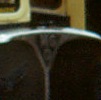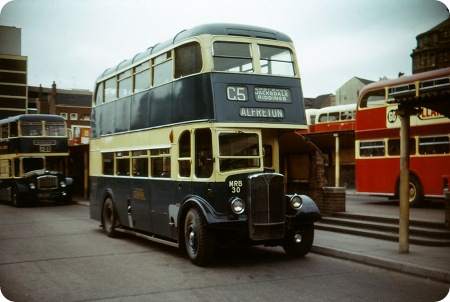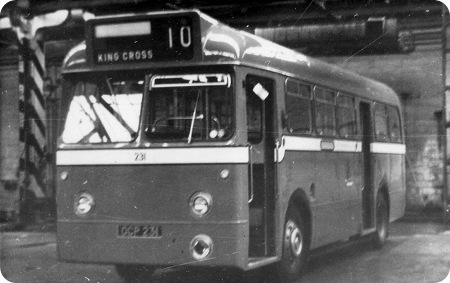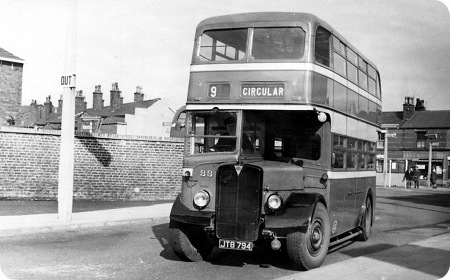Midland General – AEC Regent III – MRB 30 – 28
Midland General Omnibus Company
1948
AEC Regent III
Weymann H30/26R
From what I can make out there was the Midland General Group which included Midland General obviously, Mansfield & District and Notts & Derby. One thing I find strange is that they purchased Bristol manufactured buses I thought that after 1948 only nationalised bus operators could do that. Although one thing I found out was that the general manager of the Midland General Group was also the general manager of the Lincolnshire Road Car Company which was a nationalised operator.
One interesting point is that Midland General had their initials in place of the AEC badge on the radiator as can be seen in the blow up below.

A full list of Regent III codes can be seen here.
This is Mount Street bus station, Nottingham. This is a pre-selector, and as I remember, it was quite unusual for them to be used on the C5 (and B3) Alfreton routes – more usually the crash gearbox Regent IIs. Even up to the late 1960s when the main service was run by Lodekkas, Underwood depot used to turn out two or three Regent IIs on Saturday mornings when the service frequency was doubled. The transmission sound of a crash gearbox Regent II was sheer music.
With regard to MGO’s purchase of Bristols, as I understand it the company was part of the Balfour Beatty Group. However, anticipating wholesale bus nationalisation (which didn’t actually materialise), they sold out voluntarily to the British Transport Commission. Their first foray into the Bristol marque was a series of (I think) 15 KSW6G’s in 1952. (They also tried out the prototype Lodekka – a strange and ugly contraption with a very wide exposed radiator.)
Stephen Ford
Strictly speaking, Balfour Beatty were nationalised because they were an electricity generator (for their Notts and Derby’s trolleybuses). They were handed over to THC/Tilling as a result of this. They would happily have continued with AEC/Weymann otherwise.
David Oldfield
(They also tried out the prototype Lodekka – a strange and ugly contraption with a very wide exposed radiator.)
I had to have a wry smile at the above comment, which is admittedly basically true I suppose. What many don’t realise though is that it didn’t have the equally revolutionary "Lodekka" body, but rather a modified version of the standard postwar product – recognition of this feature perhaps being eclipsed by the dramatic radiator and bonnet etc. Eventually joining West Yorkshire Road Car Co. Ltd as 822, it was renumbered with the rest of the fleet and ended its days as DX1. Ugly duckling it may have been, but it was the first practical model to abolish the awkward offside upper saloon gangway and poor headroom, and the notorious nearside leaning and rolling on cambers.
Chris Youhill
The KSW’s mentioned were delivered to Notts & Derby as replacements for the BUT trolleybuses which came off service during 1953. The prototype Lodekka was never owned by the company but spent a while with them on a trial basis however this did start a long relationship with Bristol/ECW right through to the demise (almost) of the MGO group in the 1970’s. Indeed the very last Lodekka (YNU 351G) became part of the fleet in the Autumn of 1968 and after continued service with Trent passed directly into preservation in 1980 where it still is – I was one of the original owners.
Paul D Chambers
23/03/11 – 06:50
The Barton’s low bridge decker looks like one of there NCME Regent V with the wrap around front windows a very smart looking design.
Roger Broughton
23/03/11 – 20:03
I remember these Regents with great affection and I was privileged to travel on them as a young lad! There were three batches, the MRB’s as shown were delivered new to Midland General, then the JVO’s, some of which were transferred from Mansfield District to Notts & Derby as trolleybus replacements and of course the last, the ONU’s which were lowbridge. It’s always slightly annoyed me when these ones are referred to as RLH type Regents, I’ve always felt that London Transport’s RLH’s should be described as ‘Midland General type Regents!’
The most memorable thing about all of them was the astonishing condition in which they were maintained, some of them achieved almost twenty years service and they were always turned out in pristine condition right till the end.
In their later years, there was a concentration of them at Ilkeston garage, for use on the frequent town services which involved a stiff climb up the main street with many stops and high loadings, a task which they performed with consummate ease, much better than a lumbering Lodekka! In fact, I think it wasn’t until the arrival of the semi-automatic FLF6LX Bristols that the management of MGO thought they had anything capable of replacing them.
Chris Barker
24/03/11 – 06:37
You are right about the RLHs Chris (which of course were actually diverted from MGO). Similarly, the Regent IIs which tend to get called STLs. Goodness – LT only had 20 of them. Plenty more went elsewhere, and they were about as different from proper STLs as chalk from cheese! As for the Ilkeston town services (A2 and A3) I seem to remember some of the N&DT KSW6Gs being used, in the early 60s, when they had been displaced by Lodekkas from the Nottingham – Ripley B1. I guess it was the pre-selector gearbox on the Regents that made them favourites with Bath Street hill to contend with in one direction and Nottingham Road in the other.
Stephen Ford
21/01/14 – 06:54
I hope I’m correct in this statement bur Bristol double deckers where not in service at the midland general until after 1957 to 1958…. I used to work at underwood garage 1973 to 76, and used to drive the old deckers both with Gardner engines and also with Bristol engines, these where brutes to the brain, left arm and the hearing at times when missing a gear the right leg also suffered due to the throttle being connected direct to the governor in the fuel pump.
Murray Bacon
21/01/14 – 09:09
The LW and early LX series of Gardner engines had ‘all speed’ governors which worked by setting the maximum engine speed at a level determined by the accelerator position. Pressing the throttle pedal to increase the revs acted against the resistance of the governor setting, and resulted in a heavy pedal action. When changing gear upwards with a conventional clutch/gearbox transmission, it paid to blip the engine slightly to take the load off the governor once the gear had engaged before releasing the clutch again to take up power. This obviated the tendency to jerk when the throttle pedal gave way suddenly under foot pressure.
Roger Cox
22/01/14 – 06:37
Murray, you may be right so far as Underwood was concerned, but I think Langley Mill had Bristol Lodekkas earlier than 1957. I’m almost certain they were running on the Hucknall – Alfreton C9 by 1956 at the latest. And of course there were the 15 earlier Bristol KSWs, that were actually Notts & Derby rather than MGO, which came in 1953.
Stephen Ford
22/01/14 – 14:06
Midland General’s first Lodekkas were actually delivered in 1954. One early use of them was on service 44, Derby – Chesterfield which had been instituted in that year and was regarded as a ‘flagship’ route so Alfreton garage may have had some of the first LD’s.
Chris Barker
22/01/14 – 17:56
For reference, the first Lodekka prototype LHY 949 is here www.sct61.org.uk/
John Darwent
25/01/14 – 08:12
Thanks for the link to the photos of prototype Lodekka LHY 949 John. Stephen’s earlier comments about the Lodekka prototype being a "strange and ugly contraption with a very wide exposed radiator" are, as Chris Y notes, basically true. However, if one looks at the ECW bodywork fitted to both prototypes, even though they were of differing styles, they were still quite attractive – as long as you didn’t stray around to the front end (Oooof!). It is well documented that the pair of Lodekka prototypes used some parts from the two prototype M-type chassis exhibited at the 1948 Commercial Motor Show. Intended as a beefed-up K-type with export markets in mind, the M-type was to have been available in double-deck (MD) or single deck (MS) form, and with either a Bristol AVW or Gardner LW engine, but it never went into production. Externally the main parts transferred over to the prototype Lodekkas appear to have been the wide radiators, chrome bumpers, bonnet assemblies, front mudguards and headlamps. The wide radiator did neither of the Lodekkas any favours, and the kindest comment I have read to date called it "ungainly". Considering the overall attractiveness of the bodywork, the ‘set back’ look of the cab in relation to the radiator, mudguards and bumper simply jars. Most un-Bristol/ECW-like.
Going back to Midland General Stephen, the prototype Lodekka demonstrated to the Company, plus Mansfield District and Notts & Derby, was West Yorkshire’s 822 (JWT 712).
Brendan Smith
Quick links to the - Comments Page - Contact Page - Home Page



